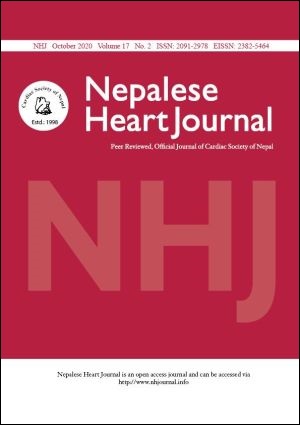Safety and Procedural Success of Transcatheter Closure of Patent Ductus Arteriosus in Adults at Shahid Gangalal National Heart Centre, Kathmandu, Nepal
DOI:
https://doi.org/10.3126/njh.v17i2.32679Keywords:
Adult, PDA, transcatheter closureAbstract
Background and Aims: Transcatheter closure of patent ductus arteriosus (PDA) using either coils or device is a well-established procedure. PDA is one of the common congenital heart diseases and it is not uncommon for it to be diagnosed in adulthood. However, only few studies are conducted in our part of the world regarding the safety and procedural success of device closure of PDA in adults. We aim to assess safety and procedural success of transcatheter closure of PDA in adults at Shahid Gangalal National Heart Centre, Kathmandu, Nepal.
Methods: It was a single center, retrospective study. Cardiac catheterization laboratory records of all consecutive adult patients (age ≥ 18 years) who underwent PDA device closure between March 2007 to March 2020 were reviewed. Patients age, gender, device size and device type along with procedural success of the procedure were reviewed. Any complication recorded was reviewed.
Results: During the study period 118 adult patients were attempted for transcatheter closure of PDA. In three cases transcatheter closure was not attempted. In one patients attempt was made to close the duct with cook coil which embolized to pulmonary artery. PDA was successfully closed in 114 patients. Among the 114 patients, 87 were females and 27 were male. Age ranged from 18 to 69 years with mean age was 29.5 years. PDA size ranged from 3mm to 18mm with the mean of 6.9mm. In two patients, residual PDA after surgical closure were closed. Amplatzer duct occluder was the most commonly used device used in 89 (78%) patients followed by Memopart PDA device in 11 (9.6%) patients, Amplatzer Muscular VSD occluder in four patients. Device size of “8x10” in 32 patients and “10x12” device in 29 patients, were the most commonly used device size.
Conclusion: Transcatheter closure of PDA in adults can safely be done with high success rate.
Downloads
Downloads
Published
How to Cite
Issue
Section
License
This license enables reusers to distribute, remix, adapt, and build upon the material in any medium or format, so long as attribution is given to the creator. The license allows for commercial use.




